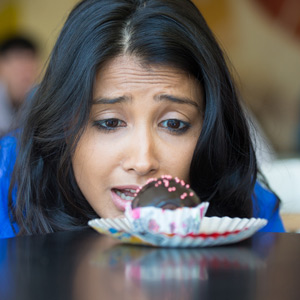A Little Bit of Diabetes

The Indian party was in full swing. The ladies gossiped in the kitchen and rolled dough, and the men smoked and sipped whiskey in the den. One of our ‘uncles’ popped a second gulab jamun sweet in his mouth, prompting a raised eyebrow from one of the doctors in attendance.
“Oh,” said the Indian ‘uncle,’ “I just have a little bit of diabetes.”
Unfortunately, we hear this a lot in the South Asian community. Blame denial, blame blood tests that represent early diabetes as a small-appearing number instead of a scary, high number found in a cholesterol panel, blame a cultural obsession with sugar, but South Asians often minimize this maddening dysregulation of the body. The truth is that, once that little number isn’t normal, it means that the body is already suffering as a result of that dysregulation.
Sadly, we can’t afford to ignore it. There is an entire coterie of genetic variants that promote South Asian Type II diabetes; the cells of brown people too often just start ignoring insulin and allowing sugar molecules to accumulate in the blood stream, like pollution particulates.1 The result of these unfortunate genes and, yes, our cultural tendencies and questionable food and portion choices, make our percentage of diabetes cases twice what they should be relative to our population. Diabetics can suffer gangrenous limbs, kidney failure, blindness, and loss of sensation in the hands and feet.
It gets worse; South Asians independently have other risk factors for heart disease, such as a tendency to have the MTHFR mutation that encourages blood clotting. Put all this together, and no wonder South Asians have a higher likelihood of clogged arteries, heart attacks, and strokes.
But as a largely highly educated ethnic group, South Asians have the opportunity to not detonate that ticking time bomb. The bomb can be defused instead, with diet and exercise—real diet and exercise, athlete-style, not “Maybe on Sunday I will take a walk after dinner.”
I recommend that South Asian patients (you don’t have to be sick to be a patient!) adopt a very aggressive anti-diabetes and anti-heart disease plan. Dairy should be an unusual treat. That daily milk in tea is a privilege, not a right; and it doesn’t prevent bone fractures from osteoporosis, either. Vegetable intake should be heavy and varied. And the white toast, fried potatoes, plates ¾ filled with white rice? Our genes simply aren’t designed to handle them. For a simple test, eat 4 ounces of white rice followed an hour later by a blood sugar check, compared with 4 ounces of spinach, and note the difference in blood sugar.
South Asian culture has frankly pooh-poohed physical activity for hundreds of years. How many children have heard these words: “Don’t run around or you will be sweaty.” “Don’t play tennis outside because you get too dark.” Somehow, an entire culture has remained in colonial times, when the rich signified their status with zero muscle definition and relatively pale skin from not having to do hard labor outdoors. The South Asian metabolism doesn’t put on muscle easily, the way African-American bodies do, and does put in abdominal fat easily, which further predisposes to cardiac disease. The upshot is that South Asians actually have to work out harder to achieve the same level of fitness, longevity, and health as people from different races. Luckily, we will have new role models of color in the Rio Olympics, with Indian athletes competing in gymnastics, tennis, badminton, and more. Families should take their cues from these athletes, and not from the spectators comfortably seated and watching them.
That particular uncle, the one with a little bit of diabetes, was a doctor himself. You’d think that doctors would know better than to consume multiple sugar-soaked balls of fried white dough at a party, but there’s a big difference between what we want to eat and what science says we should eat.
South Asians can indeed beat their genetics—but it requires more than a little bit of vigorous exercise, significant diet changes, and working with doctors and nutritionists to conquer the odds.
Citation:
1 - http://www3.imperial.ac.uk/newsandeventspggrp/imperialcollege/newssummary/news_30-8-2011-11-40-47
This month’s guest columnist, Monya De, MD MPH, is an internist and a freelance journalist. Read her tweets at https://www.twitter.com/medjournalist.
Column host, Gulshan Harjee, M.D., is a board certified internist in private practice with an emphasis on prevention. Please email your health and medical questions for consideration in this column to: gharjee@ comcast.net. The material in this column is of a general nature, and must not be construed as specific medical advice. This column rotates monthly along with the Fitness Lifestyle column by Aarti Patel.
Enjoyed reading Khabar magazine? Subscribe to Khabar and get a full digital copy of this Indian-American community magazine.
blog comments powered by Disqus










